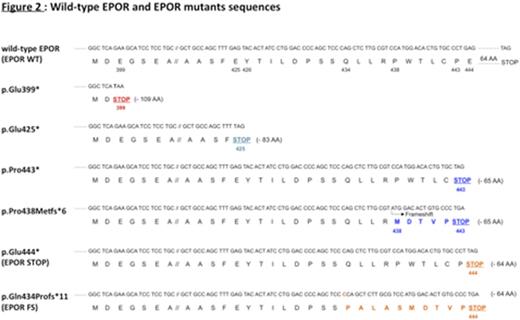Abstract

Primary Familial and Congenital Polycythemia (PFCP) is a non-malignant pathology of the erythroid lineage, characterized by an isolated increase of the red cell mass without evolution into myelofibrosis or acutisation. Around twenty constitutive non-sense and missense mutations located in the exon 8 of the erythropoietin receptor (EPOR) gene have been described so far. They all lead to the truncation of the C-terminal part of the protein and the loss of several cytoplasmic tyrosines. The erythropoietin (EPO) hypersensitivity of the PFCP erythroid progenitors is usually explained by the disappearance of these negative signaling regulation and internalization domains (Figure 1a). Nonetheless, relatively few functional studies have been carried out. We therefore investigated the mechanism of EPOR mutations in PFCP.
We identified and extensively studied a new constitutive heterozygous frameshift EPOR mutation, p.Gln434Profs*11, which generates a new 11 amino acid (AA) C-terminal tail and a STOP codon at position 444, leading to the truncation of 63 AA of the wild-type receptor (Figure 1c). The primary progenitor cells displayed a major hypersensitivity to EPO, similar to Polycythemia Vera (PV) patients, as well as a spontaneous and persistent JAK2 and STAT5 phosphorylation, compared to the control cells. To study the mechanism of this new EPOR mutant, Ba/F3 cells were transduced with different retroviruses encoding either the HA-tagged wild-type EPOR (EPOR WT)or a truncated receptor at position 444, p.Gln444* (EPOR STOP) or the frameshift EPOR p.Gln434Profs*11mutation (EPOR FS), identical to the patient's mutation (Figure 2). As observed in primary cells, EPOR FS conferred a spontaneous STAT5 phosphorylation and a 4- to 5-fold EPO hypersensitivity to Ba/F3 cells (IC50 of 0.003 U/mL vs 0.01 U/mL) compared to both EPOR WT and EPOR STOP. As expected, the loss of negative regulatory domains in the C-terminal part of the receptor induced a persistent STAT5 activation in EPOR FS and EPOR STOP Ba/F3 cells. Moreover, EPOR FS was more stable (half-life of 120 minutes vs 60 minutes) and displayed a higher level of localization at the cell surface (more than 2-fold), compared to EPOR WT and EPOR STOP. However, no modification of the EPOR FS internalization pattern was observed during 125I-EPO labeling experiments and cytometry analysis. Furthermore, a dileucine motif, known to be a potential clathrin-dependent endocytosis site, is lost in the new C-terminal tail of EPOR FS mutant, yet its abrogation in EPOR WT and EPOR STOP did not modify the phenotype of Ba/F3 cells. Therefore, unlike previous reports, the major EPO hypersensitivity induced by EPOR p.Gln434Profs*11 cannot be explained by the receptor truncation, but rather by the appearance of a new C-terminal tail that confers spontaneous signaling.
We wondered if this model could be extended to other EPOR mutations already described in PFCP (Figures 1a-b and 2). We therefore measured the impact on Ba/F3 cells proliferation of the frameshift EPOR p.Pro438Metfs*6 and its non-sense mutant counterpart, p.Pro443*, which retains the tyrosine at position 426, a binding site for the negative signaling regulators SOCS3 and CIS. EPO-hypersensitivity (4- to 5-fold) was only induced by EPOR p.Pro438Metfs*6, suggesting a common mechanism for the frameshift EPOR mutations. Interestingly, two proximal non-sense mutations, EPOR p.Glu399* and p.Glu425*, lacking 7 of the 8 cytoplasmic tyrosines that compose EPOR negative regulatory and internalization domains, were also able to confer a high EPO hypersensitivity to Ba/F3 cells.
To our knowledge this is the first extensive functional study of EPOR mutations in PFCP. We highlighted that this pathology is much more complex than expected, since different mechanisms are involved in the EPO hypersensitivity phenotype, according to the type of EPOR mutation. Indeed, extensive truncations are sufficient by themselves to confer the EPO hypersensitivity phenotype due to the loss of all negative regulatory and internalization domains, whereas more distal truncations induced by frameshift mutants confer EPO hypersensitivity because of the appearance of a new C-terminal tail. The latter, by increasing EPOR stability at the cell surface, may cause pre-activation of both receptor and JAK2, constitutive signaling and hypersensitivity to EPO close to that of JAK2V617F-positive PVs.
No relevant conflicts of interest to declare.
Author notes
Asterisk with author names denotes non-ASH members.

This icon denotes a clinically relevant abstract



